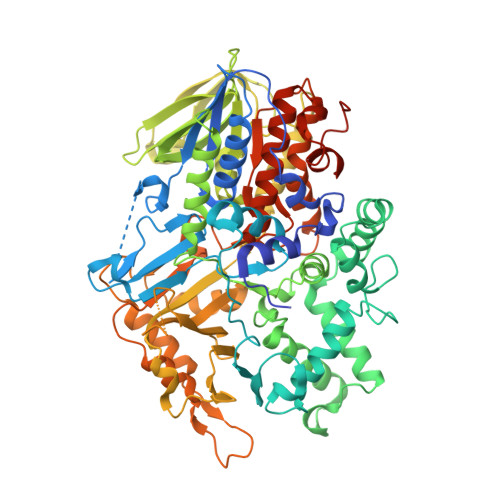High resolution X-ray crystal structures of L-phenylalanine oxidase (deaminating and decarboxylating) from Pseudomonas sp. P-501. Structures of the enzyme-ligand complex and catalytic mechanism
Ida, K., Suguro, M., Suzuki, H.(2011) J Biochem 150: 659-669
- PubMed: 21841183
- DOI: https://doi.org/10.1093/jb/mvr103
- Primary Citation of Related Structures:
3AYI, 3AYJ, 3AYL - PubMed Abstract:
The mature form of L-Phe oxidase of Pseudomonas sp. P-501 (PAOpt) catalyzes the oxygenative decarboxylation of L-Phe and the oxidative deamination of L-Met, and is highly specific for L-Phe. The crystal structures of PAOpt individually complexed with L-Phe and L-Met and the properties of the active site mutants were investigated to clarify the structural basis of the substrate and reaction specificities of the enzyme. The benzene ring of L-Phe is packed in six hydrophobic amino acid side chains versus the two hydrophobic side chains of L-amino acid oxidase (LAO, pdb code: 2jb2); the distance between the substrate C¦Á atom and water is shorter in the PAOpt-L-Met complex than in the PAOpt-L-Phe complex; and the mutation of substrate carboxylate-binding residues (Arg143 and Tyr536) causes the enzyme to oxidize L-Phe and decreases the charge-transfer band with L-Phe. These results suggest that (i) the higher substrate specificity of PAOpt relative to LAO is derived from the compact hydrophobic nature of the PAOpt active site and (ii) the reactivity of the PAOpt charge-transfer complex with water or oxygen determines whether the enzyme catalyzes oxidation or oxygenation, respectively.
Organizational Affiliation:
Department of Biosciences, School of Science, Kitasato University, Kitasato 1-15-1, Sagamihara, Kanagawa 252-0329, Japan.




















